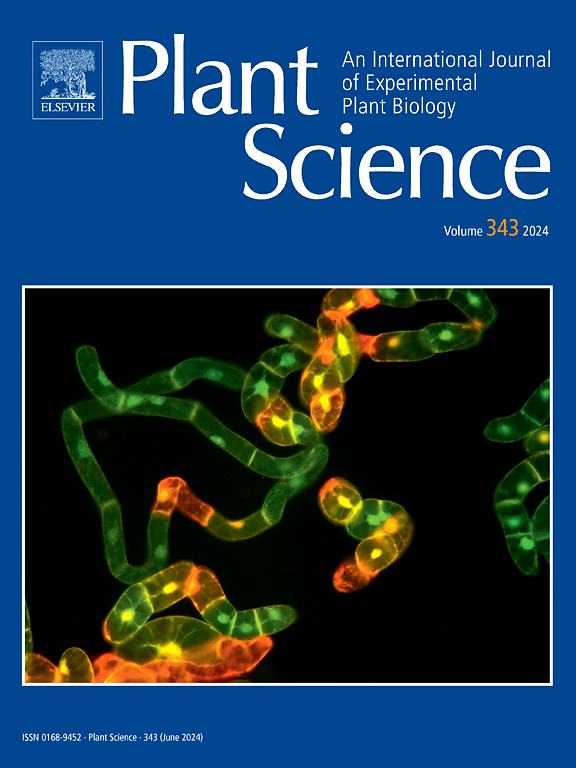Overexpression of maize transcription factor ZmNF-YC14 positively regulates drought and salt stress responses in Arabidopsis thaliana
IF 4.2
2区 生物学
Q2 BIOCHEMISTRY & MOLECULAR BIOLOGY
引用次数: 0
Abstract
Maize (Zea mays L.) is a food crop with the largest planted area globally and one of the highest total yields worldwide. However, in recent years, deteriorating climate, increasing scarcity of freshwater resources, and rising land salinity have caused drought and salinity stress to be the two major factors that restrict crop growth, development, and yield, significantly affecting crop production and ecological sustainability. Nuclear factor Ys (NF-Ys) are an important class of transcription factors (TFs); however, their roles in plant stress tolerance responses and the underlying molecular mechanisms remain largely unknown. In this study, we conducted a bioinformatic analysis of 17 members of the maize NF-YC family and examined the ZmNF-YC14 gene through multiple sequence alignment among different species and HFD_NF-YC-like functional domains. Reverse transcription quantitative PCR (RT-qPCR) results indicated that ZmNF-YC14 exhibited the highest expression levels in maize leaves and was positively expressed under both drought and salt stress treatments. Western blot analysis revealed a distinct band at 27.68 kDa. Analyses of Escherichia coli BL21 and yeast strains confirmed that ZmNF-YC14 plays a biological role in enhancing tolerance to salt and drought stress. Arabidopsis plants overexpressing ZmNF-YC14 demonstrated reduced levels of hydrogen peroxide, superoxide anion, and malondialdehyde while exhibiting increased peroxidase, catalase, and superoxide dismutase activities after drought and salt stress treatments. This effect was attributed to the reciprocal relationship between ZmNF-YC14 and its downstream target gene ZmCONSTANS-LIKE16. Therefore, ZmNF-YC14 and ZmCONSTANS-LIKE16 may be essential for the response to abiotic stresses such as drought and salt stress in maize. They play a crucial role in the development of new germplasm, cultivation of new maize varieties, addressing the 'necklace' problem in crop breeding, and ensuring national food security.
玉米转录因子ZmNF-YC14的过表达正调控拟南芥的干旱和盐胁迫响应
玉米(Zea mays L.)是全球种植面积最大、总产量最高的粮食作物之一。然而,近年来,气候的恶化、淡水资源的日益稀缺和土地盐度的上升,使得干旱和盐胁迫成为制约作物生长发育和产量的两大因素,严重影响了作物生产和生态可持续性。核因子Ys (NF-Ys)是一类重要的转录因子;然而,它们在植物抗逆性反应中的作用和潜在的分子机制在很大程度上仍然未知。在本研究中,我们对玉米NF-YC家族的17个成员进行了生物信息学分析,并通过不同物种间的多序列比对和hfd_nf - yc样功能域对ZmNF-YC14基因进行了检测。反转录定量PCR (RT-qPCR)结果表明,ZmNF-YC14在玉米叶片中表达量最高,在干旱和盐胁迫下均呈阳性表达。Western blot分析显示在27.68 kDa处有明显的条带。对大肠杆菌BL21和酵母菌株的分析证实,ZmNF-YC14在增强耐盐和干旱胁迫方面发挥生物学作用。过表达ZmNF-YC14的拟南芥植株在干旱和盐胁迫处理后,过氧化氢、超氧阴离子和丙二醛水平降低,过氧化物酶、过氧化氢酶和超氧化物歧化酶活性增加。这种效应归因于ZmNF-YC14与其下游靶基因ZmCONSTANS-LIKE16之间的互反关系。因此,ZmNF-YC14和ZmCONSTANS-LIKE16可能在玉米对干旱和盐胁迫等非生物胁迫的响应中起重要作用。它们在开发新种质、培育玉米新品种、解决作物育种中的“项链”问题以及确保国家粮食安全方面发挥着至关重要的作用。
本文章由计算机程序翻译,如有差异,请以英文原文为准。
求助全文
约1分钟内获得全文
求助全文
来源期刊

Plant Science
生物-生化与分子生物学
CiteScore
9.10
自引率
1.90%
发文量
322
审稿时长
33 days
期刊介绍:
Plant Science will publish in the minimum of time, research manuscripts as well as commissioned reviews and commentaries recommended by its referees in all areas of experimental plant biology with emphasis in the broad areas of genomics, proteomics, biochemistry (including enzymology), physiology, cell biology, development, genetics, functional plant breeding, systems biology and the interaction of plants with the environment.
Manuscripts for full consideration should be written concisely and essentially as a final report. The main criterion for publication is that the manuscript must contain original and significant insights that lead to a better understanding of fundamental plant biology. Papers centering on plant cell culture should be of interest to a wide audience and methods employed result in a substantial improvement over existing established techniques and approaches. Methods papers are welcome only when the technique(s) described is novel or provides a major advancement of established protocols.
 求助内容:
求助内容: 应助结果提醒方式:
应助结果提醒方式:


